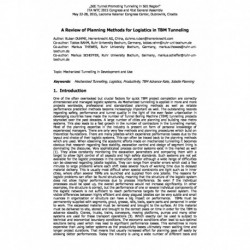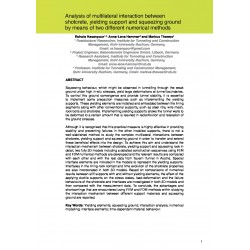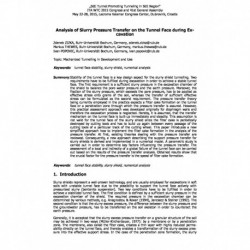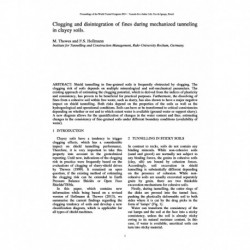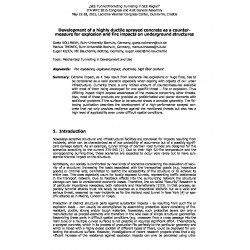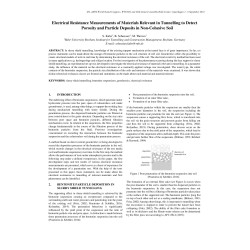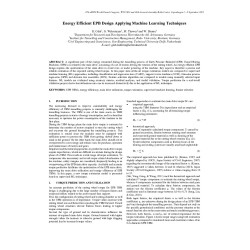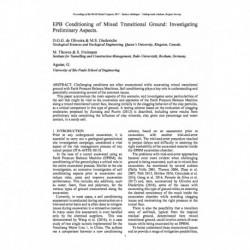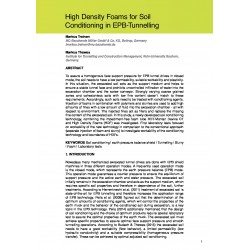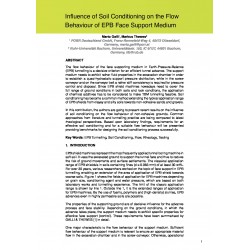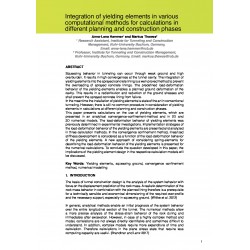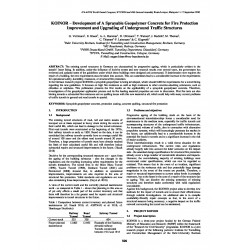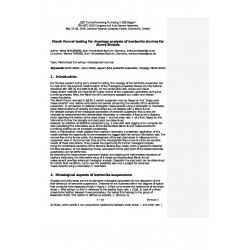No document
Search & filter
Search for a publication
Search & filter
List of products by author: M. Thewes
- 1
- 2
-
A Review of Planning Methods for Logistics in TBM Tunneling
Abstract: One of the often overlooked but crucial factors for quick TBM project completion are correctly dimensioned and managed logistic systems. As Mechanized tunnelling is applied in more and more projects worldwide, professional and standardized planning methods as well as reliable performance prediction methods become increasingly important as well. The outstanding records regarding safety,...
0,00 € -
Analysis of multilateral interaction between shotcrete, yielding support and squeezing ground by means of two...
Abstract: Squeezing behaviour, which might be observed in tunnelling through the weak ground under high in-situ stresses, yield large deformations at tunnel boundaries. To control this ground convergence and provide tunnel stability, it is essential to implement some precaution measures such as implementing the yielding supports. These yielding elements are installed and embedded between the lining...
0,00 € -
Analysis of Slurry Pressure Transfer on the Tunnel Face during Excavation
Abstract: Slurry shields represent a well-proven technology, and are usually employed for excavations in soft soils with unstable tunnel face due to the possibility to support the tunnel face actively with pressurized slurry (bentonite suspension). Two key conditions have to be fulfilled in order to achieve a stabilized tunnel face. The first condition is defined by a sufficient slurry pressure in the...
0,00 € -
Clogging and disintegration of fines during mechanized tunneling in clayey soils
Abstract: Shield tunnelling in fine-grained soils is frequently obstructed by clogging. The clogging risk of soils depends on multiple mineralogical and soil-mechanical parameters. The existing approach of estimating the clogging potential, which is derived from the indices of plasticity and consistency, has proven to be beneficial for practical purposes. Furthermore, the dissolving of fines from a...
0,00 € -
Development of a highly ductile sprayed concrete as a counter-measure for explosion and fire impacts on underground...
Abstract: Extreme impact, as it may result from scenarios like explosions or huge fires, has to be considered as a valid scenario especially when dealing with objects of our urban infrastructure. Currently there is only limited amount of countermeasures available with most of them being developed for one specific threat – fire or explosion. Thus differing impact might expose weaknesses of the measure...
0,00 € -
Electrical Resistance Measurements of Materials Relevant in Tunnelling to Detect
Abstract: In slurry shield tunnelling, knowledge of the existing support mechanism at the tunnel face is of great importance. So far, no precise statements can be made about the storage of bentonite particles in the soil structure of soft soil. Geoelectrics offers the possibility to create structural models of soils in real time by determining the electrical resistance of the soil. The electrical...
0,00 € -
Energy Efficient EPB Design Applying Machine Learning Techniques
Abstract: A significant part of the energy consumed during the tunnelling process of Earth Pressure Balanced (EPB) Tunnel Boring Machines (TBMs) is related to the main drive, consisting of a set of motors driving the rotation of the cutting wheel. An energy efficient EPB design requires the optimization of the main drive to avoid over- or under powering of the machine. Key aspect is therefore a precise...
0,00 € -
EPB Conditioning of Mixed Transitional Ground: Investigating Preliminary Aspects
Abstract: Challenging conditions are often encountered while excavating mixed transitional ground with Earth Pressure Balance Machines. Soil conditioning plays a key role in understanding and potentially overcoming several of the common issues. This paper summarizes the main aspects of this scenario, and investigates some particularities of the soil that might be vital to the excavation and operation of...
0,00 € -
Evaluating the possibility of shield jamming in squeezing grounds
Abstract: Excavation of long and deep tunnels by shielded TBMs is a safe, fast, and efficient method of tunneling that mitigates many risks related to ground conditions. However, TBM applications in difficult conditions such as squeezing ground may lead to problems such as shield jamming. For successful tunneling in such conditions, it is essential to study the...
0,00 € -
High Density Foams for Soil Conditioning in EPB-Tunnelling
Abstract: To assure a homogenous face support pressure for EPB tunnel drives in closed mode, the soil needs to have a low permeability, suitable workability and plasticity. In this situation, the excavated soil acts as the support medium and helps to ensure a stable tunnel face and prohibits uncontrolled infiltration of water into the excavation chamber and the screw conveyor. Strongly varying coarse...
0,00 € -
Influence of Soil Conditioning on the Flow Behaviour of EPB Face Support Medium
Abstract: The flow behaviour of the face supporting medium in Earth-Pressure-Balance (EPB) tunnelling is a decisive criterion for an efficient tunnel advance. The support medium needs to exhibit rather fluid properties in the excavation chamber in order to establish a quasi-hydrostatic support pressure distribution, while in the screw conveyor and on the conveyor belt a rather stiff consistency is...
0,00 € -
Integration of yielding elements in various computational methods for calculations in different planning and...
Abstract: Squeezing behavior in tunneling can occur through weak ground and high overburden. It results in high convergences at the tunnel cavity. The integration of yielding elements into the sprayed concrete lining is a well-proved method to prevent the overloading of sprayed concrete linings. The predefined load-deformation behavior of the yielding elements enables a planned ground deformation of the...
0,00 € -
KOINOR - Development of a Sprayable Geopolymer Concrete for Fire Protection Improvement and Upgrading of Underground...
Abstract: The existing tunnel structures in Germany are characterised by progressive ageing, which is particularly evident in the tunnels’ inner lining. In addition, under the influence of incisive events and new research results over several years, the government has reviewed and updated some of the guidelines under which these buildings were designed and constructed. If deterioration now requires the...
0,00 € -
LCC as an Economic Valuation Approach for Underground Light R ail systems
Abstract: Urban public transport with underground light rail systems requires a costly transport infrastructure. For this purpose, life cycle costing (LCC) is a useful economic evaluation tool for determining and optimizing the initial and follow-up costs of subway light rail systems over their lifetime and thus also for organizing the maintenance intervals of subway stations, tunnel facilities and...
0,00 € -
Life-Cycle Costing Part 2 – The Modular-Process-Model
Abstract: The trend towards sustainable constructions in the building sector has greatly increased in recent years. For civil engineering works of transport infrastructure this development has mostly been reflected in the estimation of life-cycle costs and their components. While for the building construction sector (facility management) a large number of concepts and methods are published, there are...
0,00 € -
Marsh Funnel testing for rheology analysis of bentonite slurries for Slurry Shields
Abstract: For the face support during slurry shield tunnelling, the rheology of the bentonite suspension has to meet strict requirements. Determination of the rheological properties follows the international standards API 13B [1] and DIN 4126 [2]. On the construction site, simple and robust measurement methods are required for quality control of the suspension parameters during the tunnelling process....
0,00 €
- 1
- 2

